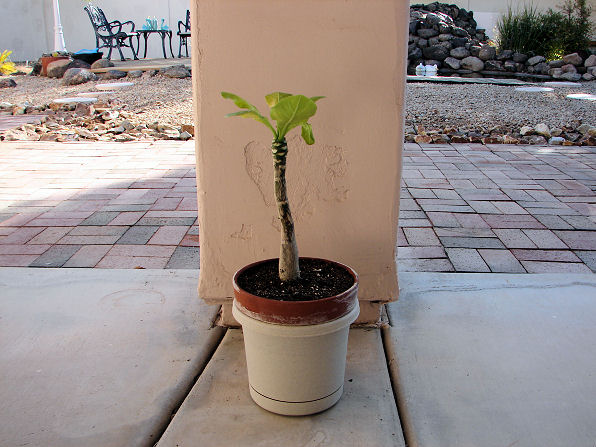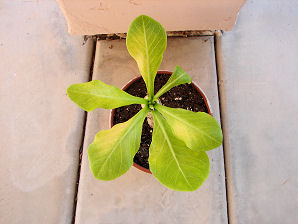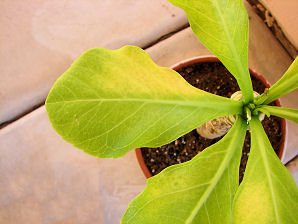Xeriscape Landscape Plants & Flowers
For The Arizona Desert Environment.
Pictures, Photos, Images, Descriptions, & Reviews.
Hawaiian Palm, Brighamia insignis.
We Are Proud Of Our SafeSurf Rating!
Click On Any Of The Following Links By Amazon.Com
For Books, & Videos About Wildflowers Of Arizona & The Southwest USA. No Obligation!
 |
| Brighamia insignis Plant, Glendale, Arizona. June 22, 2008. |
|---|
 |  |
| Brighamia insignis Leaves. | Brighamia insignis Leaf. |
|---|
 |
| Brighamia insignis Plant, Glendale, Arizona. January 13, 2009. We kept the plant on our patio in the shade and it is still doing well. |
|---|
Hawaiian Palm. Brighamia insignis, Bellflower Family ( Campanulaceae ), Hawaiian Palm. Also called: Brighamia citrina, Brighamia insignis ssp. citrina, Hawaiian Vulcan Palm, Alula, 'Olulu, Pu Aupaka, and 'Cabbage On A Stick'. We wish to thank Wikipedia, the free encyclopedia for some of the information on this page. We share images and information with Wikipedia. OK, so this is not a Xeriscape Plant! But I have a soft spot in my heart for any poor, little, abandoned, plant. This plant was sitting on the close out shelf of Lowe's and it looked almost dead. So, now I have one!! Somehow, I will try to nurse it back to health. I also will document this on the web site so that we can all learn something about it. After conducting some research concerning this unusual plant, I have learned that it is certainly worth purchasing and using as a house plant near a sunny location; or perhaps as an enclosed patio plant, where it would receive considerable shade from the sun and heat in Arizona. The Brighamia genus, with it's two species, Brighamia insignis and Brighamia rockii are not only considered as two of Hawaii's more unusual plants but they are also considered to be very rare. In fact, the present ranges of the two species are on the steep north-facing cliffs of Kaua�i, in the case of B. insignis; and of Moloka�i in the case of B. rockii. Brighamia insignis grows on sea cliffs from sea level to 1,300 feet on the Napali Coast and Ha'upu Ridge of Kaua'i. It previously grew on the Ka'ali Cliff on Ni'ihau, but it hasn't been reported from that island since 1947. Both species are very similar; differing mainly in flower color, and location. Both species are considered endangered and are protected under the United States Endangered Species Act. Both species have succulent stems, flower stalks that grow out from between the leaves, and tubular flowers. They usually have a stout, fleshy stem that is larger at its swollen, rounded base. Branched specimens have been observed in the wild, but are uncommon in cultivation. They normally reach heights of 3 to 6 feet and occasionally up to 15 feet in the wild. They have leaves that are bright to dark green, spoon-shaped, shiny, and leathery. The leaves can reach about from 4 to 8 inches in length and they form a dense rosette at the top of the stem. Each flower cluster of Brighamia insignis consists of from 3 to 8 fragrant, cream to yellow, 4 inch long, trumpet-shaped flowers n the leaf axils. They bloom from September to November. Their fragrance is said to be similar to mild honeysuckle. The fruit is a green capsule about 1/2 to 7/10 inches long containing numerous seeds. It ripens 6 - 8 weeks after pollination. When mature, the green to cream - yellow capsule splits open releasing its many small, smooth, seeds. It is said that cultivated plants may begin to flower as early as their first year, but usually not for two or three years. Hand pollination is used for seed production since the native pollinator is presumed to be extinct. From the Brighamia flower morphology, it is assumed that a large, long-tongued moth pollinated this species. TOO MUCH WATER WILL ROT THE ROOTS. Once one is growing, limit the plant to about one cup of water a month. It would depend upon the location.
Quick Notes:
Height: Up to 2 feet to 3 feet high and 2 feet wide in a pot. 6 to 12 feet in open cultivation.
Flowers: Cream to yellow, 4 inch long, trumpet-shaped flowers.
Flowering Time: Phoenix Arizona, Unknown.
Seeds: Many pale, ovoid (egg-shaped) seeds that are 0.8-1.2 mm long are produced within a single fruit. The seeds have tiny raised bumps over their entire surface. The fruit of Brighamia is a small (1.3-1.9 cm long and 0.9-1.3 cm wide) two celled capsule, which is dry at maturity, with each cell splitting along two lines to release the seeds.
Leaves: The leaves glossy green, semi-deciduous, spirally arranged, clustered toward the tips of the shoots, simple, entire, leathery in texture, 5-15 cm long and 1-8 cm broad.
Found: Native to rocky ledges with little soil or steep sea cliffs from near sea level to about 1,300 feet on the Napali Coast of Kaua`i, Hawaii.
Hardiness:
Soil pH requirements:
Sun Exposure:
Elevation: 0 to 1,300 feet. In Hawaii Landscapes.
Habitat: It grows well in Cactus Potting Soil. It needs good drainage and aeration.
Miscellaneous: Photos Taken At Glendale, Arizona June 22, 2008.
|
We Are Proud Of Our SafeSurf Rating!
Click On Any Of The Following Links By Amazon.Com
For Books, & Videos About Wildflowers Of Arizona & The Southwest USA. No Obligation!
| © 1966 - Present, Audrey, Eve, & George DeLange |
